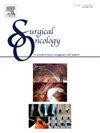A phase 1 study of intra-arterial CBL0137 in extremity melanomas and sarcomas
IF 2.4
4区 医学
Q3 ONCOLOGY
引用次数: 0
Abstract
Introduction
Regional therapies for cancer leverage the ability to isolate the circulation to a diseased extremity or organ and deliver high doses of chemotherapy that would be systemically prohibitive due to toxicity. Virtually all regional therapies utilize the original chemotherapy agent, melphalan, which requires circulatory isolation. CBL0137 is a small molecule with multiple anti-tumor effects when given intra-arterially (IA) that shows similar efficacy to melphalan in preclinical models, but without the need for circulatory isolation.
Materials and methods
Patients with advanced, unresectable melanoma or sarcoma (n = 5, sarcoma 60 %, melanoma 40 %) of the extremity entered a rapid dose-escalation phase of a clinical trial of IA CBL0137. CBL0137 was administered via a single IA catheter placed proximal to the site of tumor(s) in the affected extremity and delivered over 15 min. Primary objective was to define dose-limiting toxicities with secondary objectives of assessing response and pharmacokinetics (PK).
Results
The treatments were well tolerated with minimal to no toxicity for all patients. PK data showed predictable, dose-dependent drug exposures with rapid tissue uptake and markedly decreased systemic concentrations as compared to matched intravenous dosing data. CBL0137 preferentially accumulated within tumor tissue as compared to surrounding normal tissue in the infused limb without the need for tourniquet. Sixty percent of patients treated in this protocol would not have been eligible for standard regional therapies with one patient demonstrating prolonged disease stability while avoiding major amputation.
Conclusions
The historic restrictions of standard regional therapies may be overcome with IA CBL0137, and this treatment is potentially applicable to a wide range of cancers beyond the extremities.
动脉内CBL0137治疗四肢黑色素瘤和肉瘤的一期研究
局部癌症治疗利用将血液循环隔离到患病肢体或器官的能力,并提供高剂量的化疗,这将是由于毒性而全身禁止的。几乎所有的局部治疗都使用最初的化疗药物美法兰,这需要循环隔离。CBL0137是一种具有多种抗肿瘤作用的小分子,当动脉内给药(IA)时,在临床前模型中显示出与美法兰相似的疗效,但不需要循环分离。材料和方法患有晚期,不可切除的黑色素瘤或肉瘤(n = 5,肉瘤60%,黑色素瘤40%)的患者进入IA CBL0137临床试验的快速剂量递增阶段。CBL0137通过放置在受影响肢体肿瘤近端处的单根IA导管给药,给药时间超过15分钟。主要目的是确定剂量限制性毒性,次要目的是评估反应和药代动力学(PK)。结果所有患者均具有良好的耐受性,毒性最小至无毒性。PK数据显示,与匹配的静脉给药数据相比,可预测的剂量依赖性药物暴露具有快速的组织摄取和显着降低的全身浓度。在不需要止血带的情况下,与周围正常组织相比,CBL0137在输注肢体的肿瘤组织中优先积累。该方案治疗的60%的患者不符合标准的局部治疗条件,其中一名患者表现出长期的疾病稳定性,同时避免了大面积截肢。结论IA CBL0137可以克服标准局部治疗的局限性,这种治疗方法可能适用于四肢以外的广泛癌症。
本文章由计算机程序翻译,如有差异,请以英文原文为准。
求助全文
约1分钟内获得全文
求助全文
来源期刊

Surgical Oncology-Oxford
医学-外科
CiteScore
4.50
自引率
0.00%
发文量
169
审稿时长
38 days
期刊介绍:
Surgical Oncology is a peer reviewed journal publishing review articles that contribute to the advancement of knowledge in surgical oncology and related fields of interest. Articles represent a spectrum of current technology in oncology research as well as those concerning clinical trials, surgical technique, methods of investigation and patient evaluation. Surgical Oncology publishes comprehensive Reviews that examine individual topics in considerable detail, in addition to editorials and commentaries which focus on selected papers. The journal also publishes special issues which explore topics of interest to surgical oncologists in great detail - outlining recent advancements and providing readers with the most up to date information.
 求助内容:
求助内容: 应助结果提醒方式:
应助结果提醒方式:


